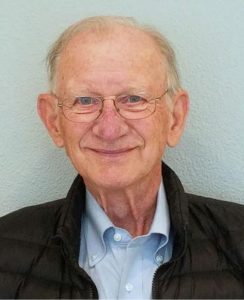
Donald Pierce
Don Pierce had a habit of continuing email threads with his collaborators years after a previous message without missing a beat in the conversation. Such instant-restart conversations reflected a profound intellectual concentration, a dogged pursuit of deeper understanding, and the special importance he placed on his collaborative relationships. These conversations continued in a cogent, coherent, and intellectually fierce manner even up to the weeks before his death at age 82. Don died in July 2022 after a random and brutal beating at a bus stop.
Early in his career at Oregon State University, Don was influenced by a series of lectures by the summer visitor David Cox, and from these developed a keen interest in the mathematics of likelihood theory, with particular concern for mathematical theory that was truly relevant to application. His focus on the translation of theoretical implications to data analysis led to important applications-oriented work and made complicated mathematical results accessible to a wide audience.
Don’s 1975 discussion contribution to Efron’s Annals of Statistics paper, “Defining the Curvature of a Statistical Problem (with Applications to Second Order Efficiency)” was the first instance of a lasting interest, which he shared with Ib Skovgaard for many years, in the interplay between geometry and inference. His related attention to higher-order asymptotics led to pioneering contributions in likelihood-based “deviance” residuals and advanced inferential techniques that could be incorporated into standard methodology and software, most notably in collaboration with Ruggero Bellio and Dawn Peters. One prestigious achievement was his discussion paper with Peters, presented at a Royal Statistical Society meeting in January 1992, “Practical use of higher-order asymptotics for multiparameter exponential families.” His proposal of methods for higher-order asymptotics in the Cox model with Bellio, among the last methodological articles he published, represents a culmination of his thinking about these problems, forty years after the initial Cox influence.
Don was also widely recognized for his methodological work on radiation health epidemiology and his analyses of mortality and cancer incidence in Japanese atomic bomb survivors. During his years of work at the Radiation Effects Research Foundation (RERF) in Hiroshima, he played a key role in developing a general class of nonlinear excess relative risk and excess rate models, and methods for fitting these using Poisson and binomial likelihood and partial likelihood techniques. These models have come to dominate analyses of radiation dose effects and are used in other fields as well. He also led a pioneering effort to develop practical methods to adjust for measurement error in the survivor dose estimates, which are now routinely used in analyses of the A-bomb survivor data. Don developed a general nonparametric approach for covariate uncertainty adjustment based on Laplace approximations and made many other contributions to radiation dose-response modeling. Some important collaborators in these areas were Michael Vaeth, Dan Stram, and particularly Dale Preston. Because of his expertise, Don played central roles in the National Academy of Sciences review of low-dose radiation exposure on health effects (BEIR VII) and in the International Commission for Radiation Protection report on extrapolating radiation risk effect estimates to low doses.
Don received a PhD in Statistics from Oklahoma State University in 1966, then joined the faculty in the Statistics Department at Oregon State University where he remained until 1996, but with several absences to visit RERF. After retirement from Oregon State, he worked full time at RERF until 2005. Between 2005 and 2015, Don served as a consultant and mentor in biostatistics and public health at Oregon Health and Science University. He was an elected fellow of the IMS and ASA, an elected member of the ISI, an Editor of the Oxford University Press Statistical Science Series, and an Associate Editor of Biometrika and Journal of the American Statistical Association.
To students, Don was thought of as smart, hard, intimidating, and deserving of respect. At both Oregon State and Oregon Health and Science University, he was recognized for his successful commitment to mentoring junior faculty. His collaborators think of him as a “real” researcher, motivated by an intense desire to learn and to learn usefully. As a person, Don was, paradoxically, both intense and gentle. His baritone voice and mental engagement projected an air of authority, but at the same time, he was a sincerely kind person, as was evident in his genuine smile.
Written by Dan Schafer, Oregon State University, with contributions from
Ruggero Bellio, Dawn Peters, Dale Preston, and Ib Skovgaard